Problem Project Framework: Strategic Planning, Processes, and Benefits
VerifiedAdded on 2023/01/19
|24
|6174
|31
Report
AI Summary
This report provides a comprehensive overview of the Problem Project Framework, designed to guide organizations and individuals in effectively addressing and solving problems through project management. It begins with an introduction highlighting the complexities of project management and the importance of decision-making processes. The report then delves into the benefits of adopting a common project management framework, including enhanced skills, integration of components, and improved project delivery. It emphasizes the significance of integrated strategic planning, communication, and coordination. The core of the report outlines the six-stage project management process (DPMF), detailing each stage from idea identification to project close-out, along with the key deliverables and decision gates at each stage. The framework provides guidance through the project lifecycle, ensuring projects stay within constraints and achieve planned results. The report also discusses the advantages of consistent project management processes, including easier comparisons, assessments, and decision-making. Overall, the report serves as a valuable resource for understanding and implementing a robust project management framework.
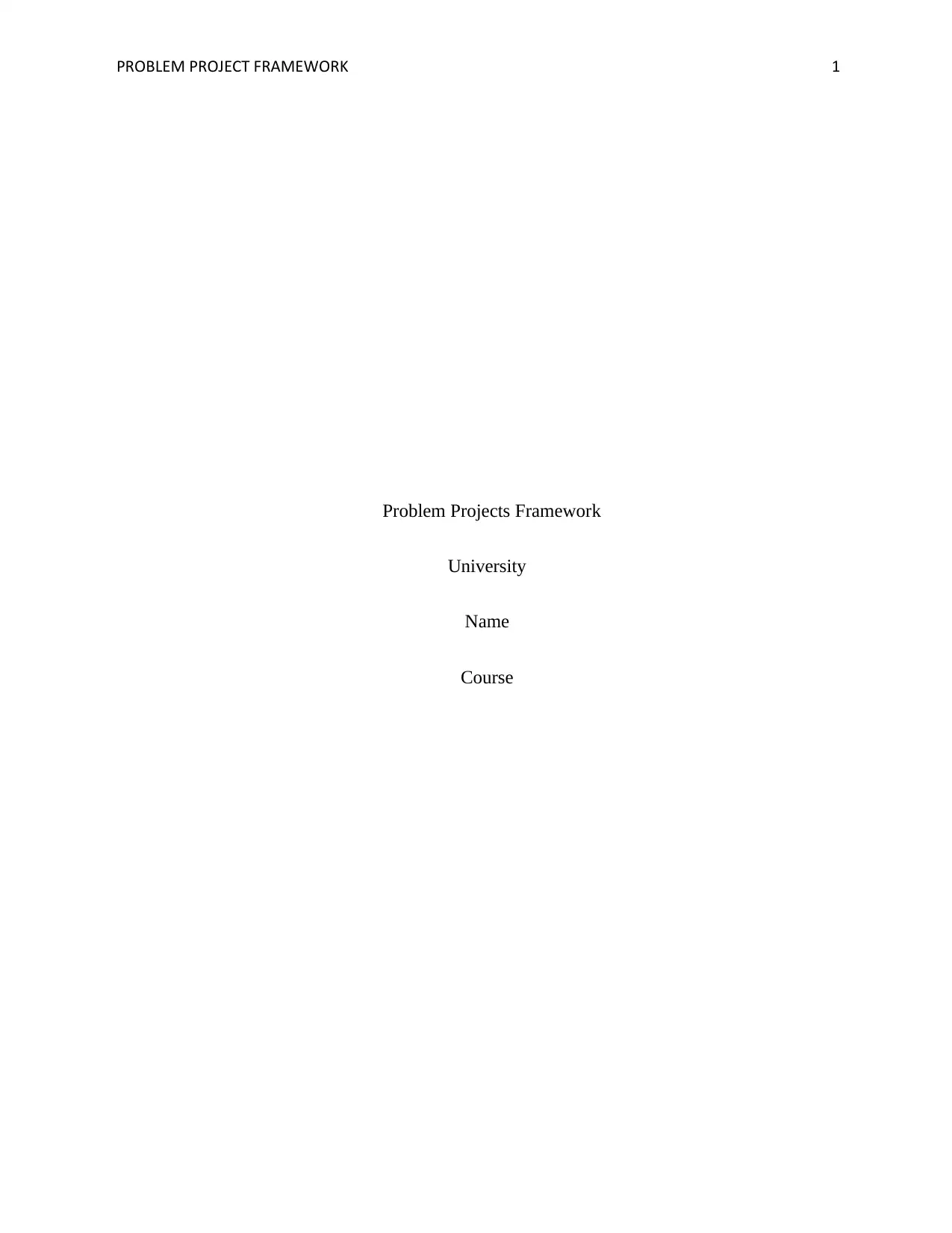
PROBLEM PROJECT FRAMEWORK 1
Problem Projects Framework
University
Name
Course
Problem Projects Framework
University
Name
Course
Paraphrase This Document
Need a fresh take? Get an instant paraphrase of this document with our AI Paraphraser
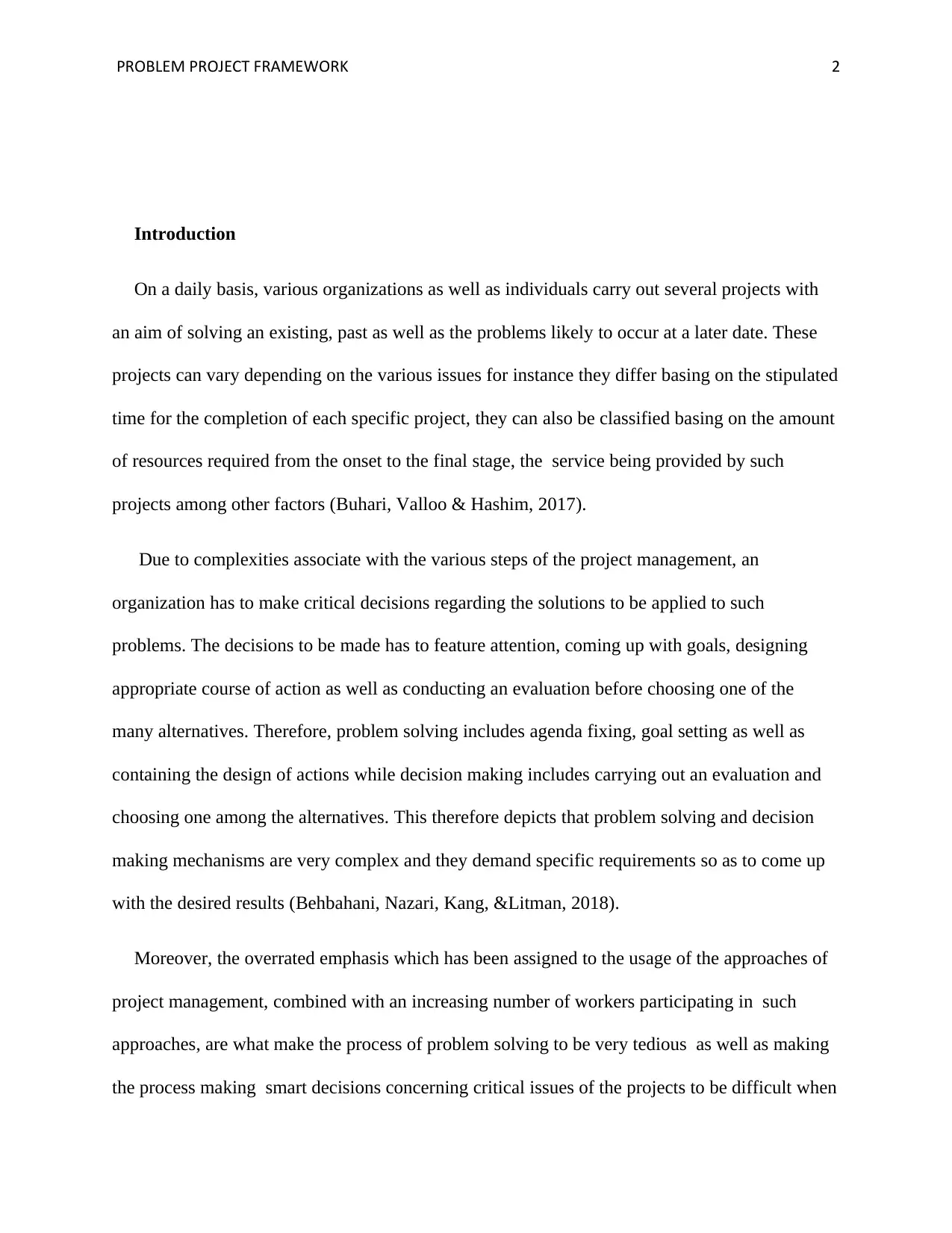
PROBLEM PROJECT FRAMEWORK 2
Introduction
On a daily basis, various organizations as well as individuals carry out several projects with
an aim of solving an existing, past as well as the problems likely to occur at a later date. These
projects can vary depending on the various issues for instance they differ basing on the stipulated
time for the completion of each specific project, they can also be classified basing on the amount
of resources required from the onset to the final stage, the service being provided by such
projects among other factors (Buhari, Valloo & Hashim, 2017).
Due to complexities associate with the various steps of the project management, an
organization has to make critical decisions regarding the solutions to be applied to such
problems. The decisions to be made has to feature attention, coming up with goals, designing
appropriate course of action as well as conducting an evaluation before choosing one of the
many alternatives. Therefore, problem solving includes agenda fixing, goal setting as well as
containing the design of actions while decision making includes carrying out an evaluation and
choosing one among the alternatives. This therefore depicts that problem solving and decision
making mechanisms are very complex and they demand specific requirements so as to come up
with the desired results (Behbahani, Nazari, Kang, &Litman, 2018).
Moreover, the overrated emphasis which has been assigned to the usage of the approaches of
project management, combined with an increasing number of workers participating in such
approaches, are what make the process of problem solving to be very tedious as well as making
the process making smart decisions concerning critical issues of the projects to be difficult when
Introduction
On a daily basis, various organizations as well as individuals carry out several projects with
an aim of solving an existing, past as well as the problems likely to occur at a later date. These
projects can vary depending on the various issues for instance they differ basing on the stipulated
time for the completion of each specific project, they can also be classified basing on the amount
of resources required from the onset to the final stage, the service being provided by such
projects among other factors (Buhari, Valloo & Hashim, 2017).
Due to complexities associate with the various steps of the project management, an
organization has to make critical decisions regarding the solutions to be applied to such
problems. The decisions to be made has to feature attention, coming up with goals, designing
appropriate course of action as well as conducting an evaluation before choosing one of the
many alternatives. Therefore, problem solving includes agenda fixing, goal setting as well as
containing the design of actions while decision making includes carrying out an evaluation and
choosing one among the alternatives. This therefore depicts that problem solving and decision
making mechanisms are very complex and they demand specific requirements so as to come up
with the desired results (Behbahani, Nazari, Kang, &Litman, 2018).
Moreover, the overrated emphasis which has been assigned to the usage of the approaches of
project management, combined with an increasing number of workers participating in such
approaches, are what make the process of problem solving to be very tedious as well as making
the process making smart decisions concerning critical issues of the projects to be difficult when
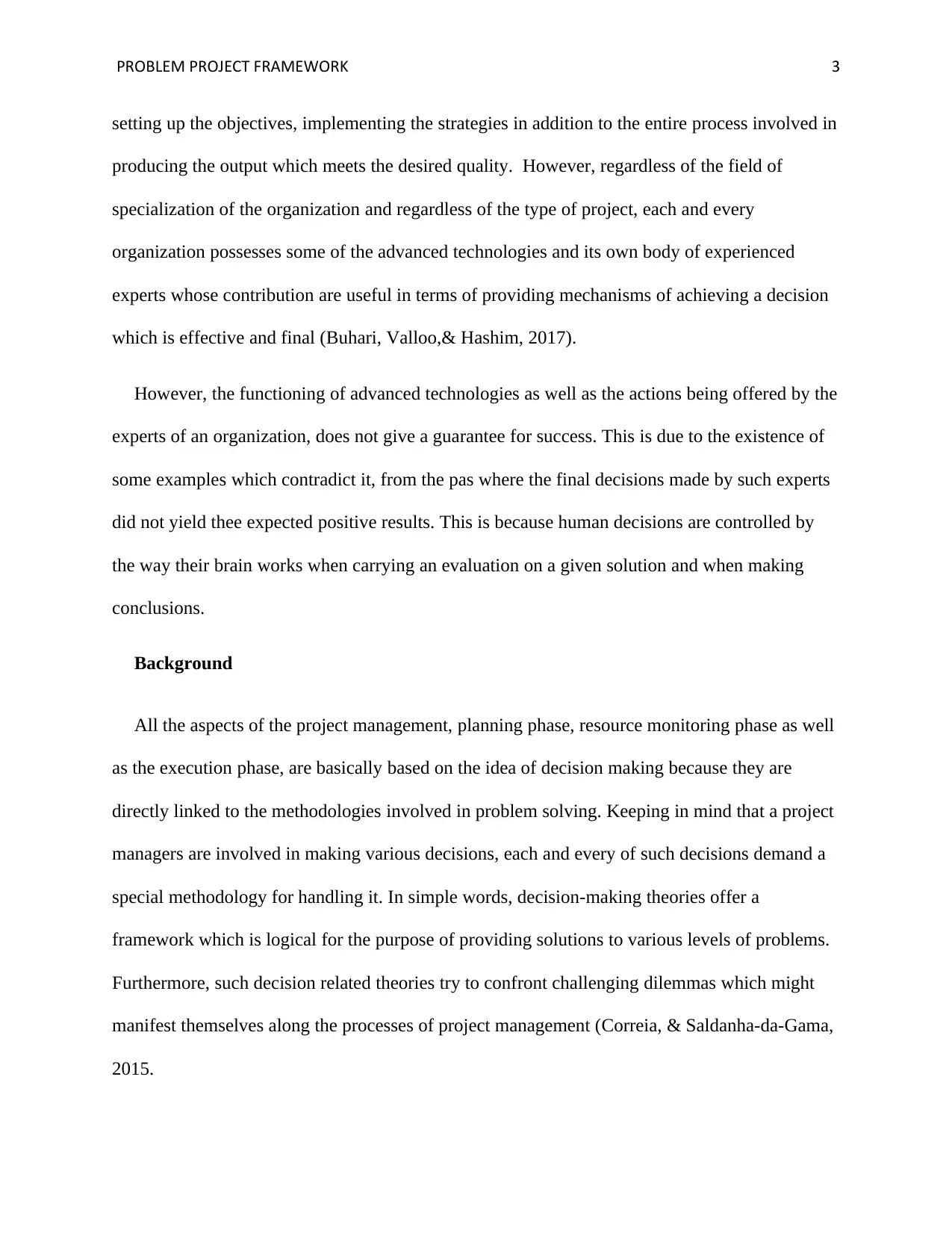
PROBLEM PROJECT FRAMEWORK 3
setting up the objectives, implementing the strategies in addition to the entire process involved in
producing the output which meets the desired quality. However, regardless of the field of
specialization of the organization and regardless of the type of project, each and every
organization possesses some of the advanced technologies and its own body of experienced
experts whose contribution are useful in terms of providing mechanisms of achieving a decision
which is effective and final (Buhari, Valloo,& Hashim, 2017).
However, the functioning of advanced technologies as well as the actions being offered by the
experts of an organization, does not give a guarantee for success. This is due to the existence of
some examples which contradict it, from the pas where the final decisions made by such experts
did not yield thee expected positive results. This is because human decisions are controlled by
the way their brain works when carrying an evaluation on a given solution and when making
conclusions.
Background
All the aspects of the project management, planning phase, resource monitoring phase as well
as the execution phase, are basically based on the idea of decision making because they are
directly linked to the methodologies involved in problem solving. Keeping in mind that a project
managers are involved in making various decisions, each and every of such decisions demand a
special methodology for handling it. In simple words, decision-making theories offer a
framework which is logical for the purpose of providing solutions to various levels of problems.
Furthermore, such decision related theories try to confront challenging dilemmas which might
manifest themselves along the processes of project management (Correia, & Saldanha-da-Gama,
2015.
setting up the objectives, implementing the strategies in addition to the entire process involved in
producing the output which meets the desired quality. However, regardless of the field of
specialization of the organization and regardless of the type of project, each and every
organization possesses some of the advanced technologies and its own body of experienced
experts whose contribution are useful in terms of providing mechanisms of achieving a decision
which is effective and final (Buhari, Valloo,& Hashim, 2017).
However, the functioning of advanced technologies as well as the actions being offered by the
experts of an organization, does not give a guarantee for success. This is due to the existence of
some examples which contradict it, from the pas where the final decisions made by such experts
did not yield thee expected positive results. This is because human decisions are controlled by
the way their brain works when carrying an evaluation on a given solution and when making
conclusions.
Background
All the aspects of the project management, planning phase, resource monitoring phase as well
as the execution phase, are basically based on the idea of decision making because they are
directly linked to the methodologies involved in problem solving. Keeping in mind that a project
managers are involved in making various decisions, each and every of such decisions demand a
special methodology for handling it. In simple words, decision-making theories offer a
framework which is logical for the purpose of providing solutions to various levels of problems.
Furthermore, such decision related theories try to confront challenging dilemmas which might
manifest themselves along the processes of project management (Correia, & Saldanha-da-Gama,
2015.
⊘ This is a preview!⊘
Do you want full access?
Subscribe today to unlock all pages.

Trusted by 1+ million students worldwide
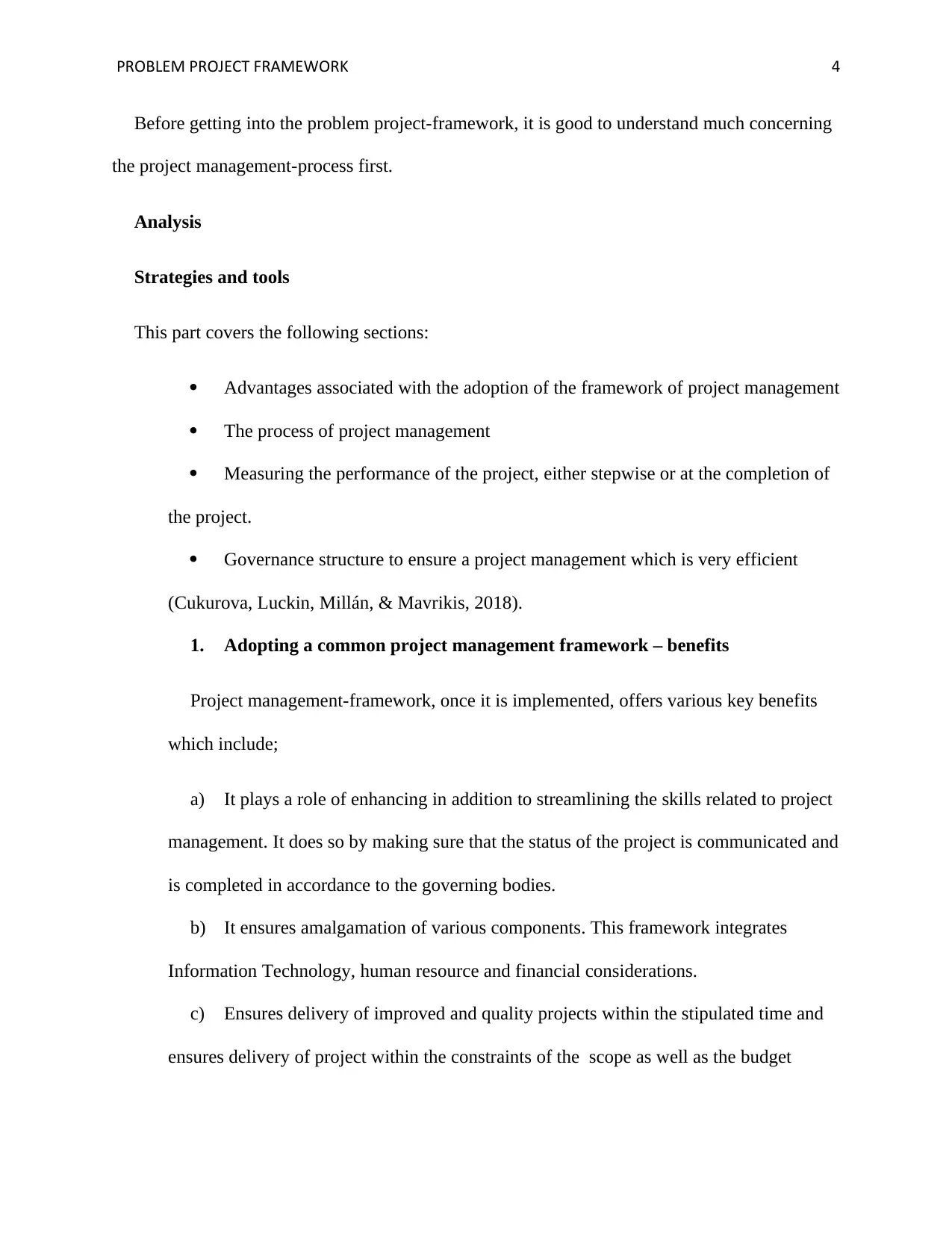
PROBLEM PROJECT FRAMEWORK 4
Before getting into the problem project-framework, it is good to understand much concerning
the project management-process first.
Analysis
Strategies and tools
This part covers the following sections:
Advantages associated with the adoption of the framework of project management
The process of project management
Measuring the performance of the project, either stepwise or at the completion of
the project.
Governance structure to ensure a project management which is very efficient
(Cukurova, Luckin, Millán, & Mavrikis, 2018).
1. Adopting a common project management framework – benefits
Project management-framework, once it is implemented, offers various key benefits
which include;
a) It plays a role of enhancing in addition to streamlining the skills related to project
management. It does so by making sure that the status of the project is communicated and
is completed in accordance to the governing bodies.
b) It ensures amalgamation of various components. This framework integrates
Information Technology, human resource and financial considerations.
c) Ensures delivery of improved and quality projects within the stipulated time and
ensures delivery of project within the constraints of the scope as well as the budget
Before getting into the problem project-framework, it is good to understand much concerning
the project management-process first.
Analysis
Strategies and tools
This part covers the following sections:
Advantages associated with the adoption of the framework of project management
The process of project management
Measuring the performance of the project, either stepwise or at the completion of
the project.
Governance structure to ensure a project management which is very efficient
(Cukurova, Luckin, Millán, & Mavrikis, 2018).
1. Adopting a common project management framework – benefits
Project management-framework, once it is implemented, offers various key benefits
which include;
a) It plays a role of enhancing in addition to streamlining the skills related to project
management. It does so by making sure that the status of the project is communicated and
is completed in accordance to the governing bodies.
b) It ensures amalgamation of various components. This framework integrates
Information Technology, human resource and financial considerations.
c) Ensures delivery of improved and quality projects within the stipulated time and
ensures delivery of project within the constraints of the scope as well as the budget
Paraphrase This Document
Need a fresh take? Get an instant paraphrase of this document with our AI Paraphraser
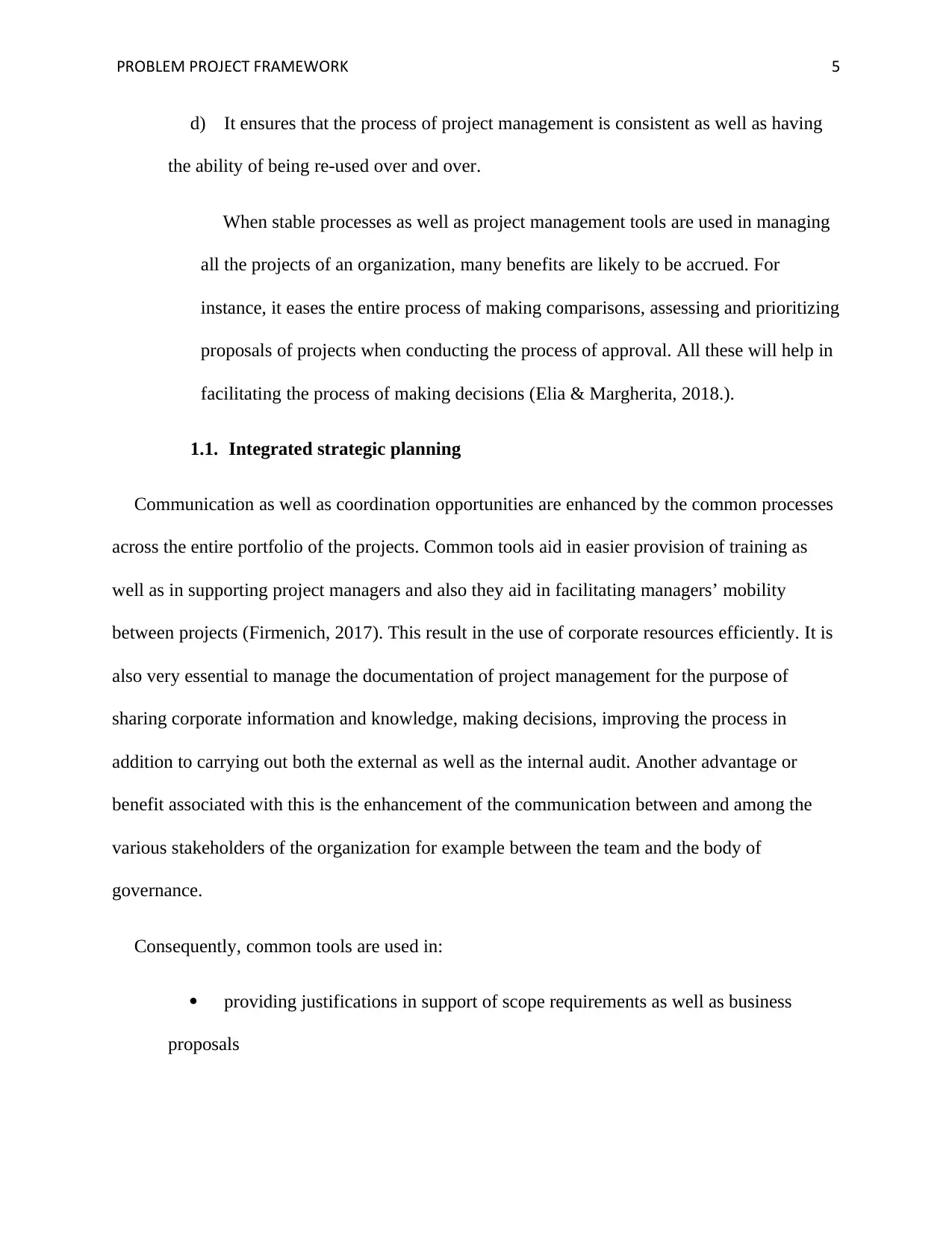
PROBLEM PROJECT FRAMEWORK 5
d) It ensures that the process of project management is consistent as well as having
the ability of being re-used over and over.
When stable processes as well as project management tools are used in managing
all the projects of an organization, many benefits are likely to be accrued. For
instance, it eases the entire process of making comparisons, assessing and prioritizing
proposals of projects when conducting the process of approval. All these will help in
facilitating the process of making decisions (Elia & Margherita, 2018.).
1.1. Integrated strategic planning
Communication as well as coordination opportunities are enhanced by the common processes
across the entire portfolio of the projects. Common tools aid in easier provision of training as
well as in supporting project managers and also they aid in facilitating managers’ mobility
between projects (Firmenich, 2017). This result in the use of corporate resources efficiently. It is
also very essential to manage the documentation of project management for the purpose of
sharing corporate information and knowledge, making decisions, improving the process in
addition to carrying out both the external as well as the internal audit. Another advantage or
benefit associated with this is the enhancement of the communication between and among the
various stakeholders of the organization for example between the team and the body of
governance.
Consequently, common tools are used in:
providing justifications in support of scope requirements as well as business
proposals
d) It ensures that the process of project management is consistent as well as having
the ability of being re-used over and over.
When stable processes as well as project management tools are used in managing
all the projects of an organization, many benefits are likely to be accrued. For
instance, it eases the entire process of making comparisons, assessing and prioritizing
proposals of projects when conducting the process of approval. All these will help in
facilitating the process of making decisions (Elia & Margherita, 2018.).
1.1. Integrated strategic planning
Communication as well as coordination opportunities are enhanced by the common processes
across the entire portfolio of the projects. Common tools aid in easier provision of training as
well as in supporting project managers and also they aid in facilitating managers’ mobility
between projects (Firmenich, 2017). This result in the use of corporate resources efficiently. It is
also very essential to manage the documentation of project management for the purpose of
sharing corporate information and knowledge, making decisions, improving the process in
addition to carrying out both the external as well as the internal audit. Another advantage or
benefit associated with this is the enhancement of the communication between and among the
various stakeholders of the organization for example between the team and the body of
governance.
Consequently, common tools are used in:
providing justifications in support of scope requirements as well as business
proposals
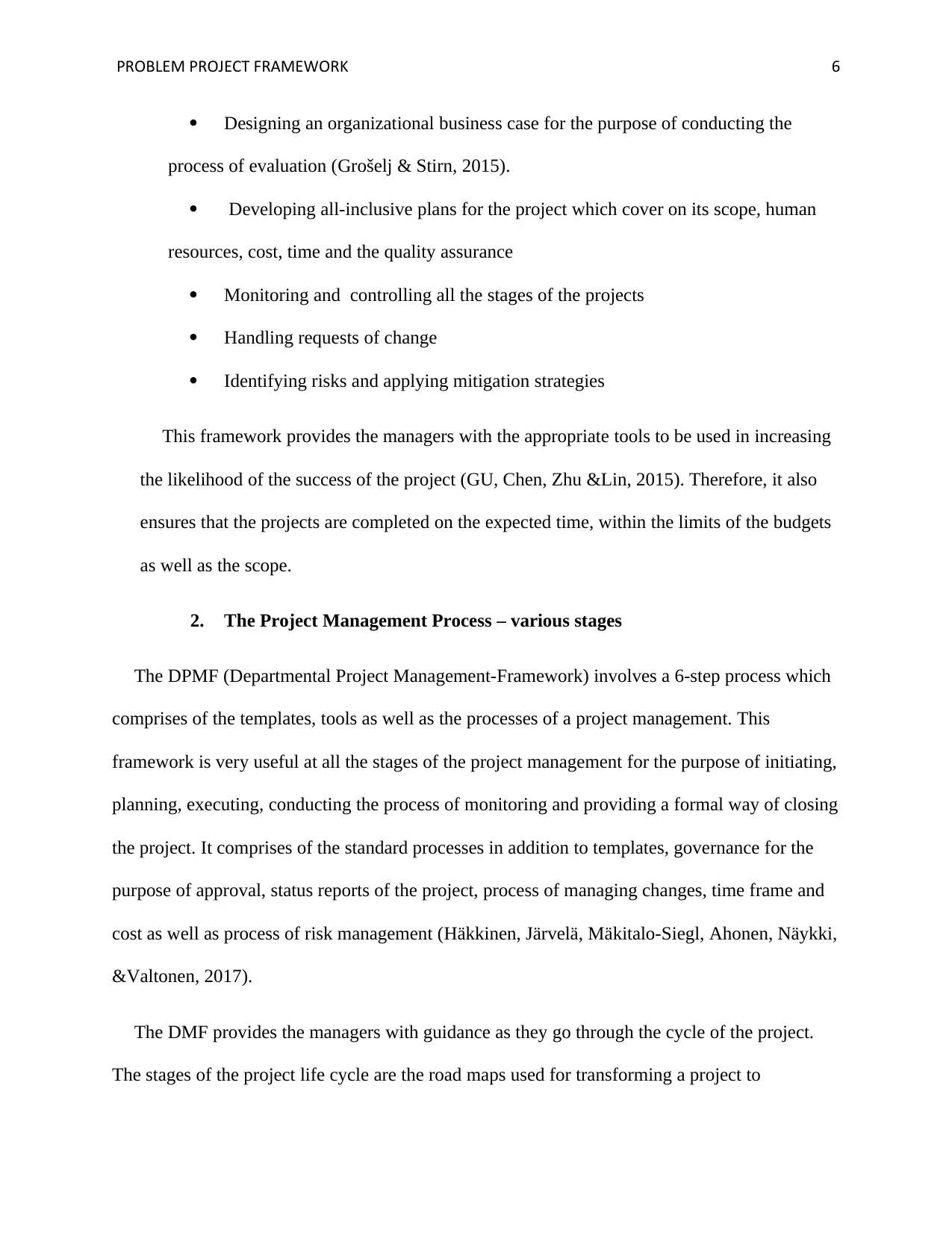
PROBLEM PROJECT FRAMEWORK 6
Designing an organizational business case for the purpose of conducting the
process of evaluation (Grošelj & Stirn, 2015).
Developing all-inclusive plans for the project which cover on its scope, human
resources, cost, time and the quality assurance
Monitoring and controlling all the stages of the projects
Handling requests of change
Identifying risks and applying mitigation strategies
This framework provides the managers with the appropriate tools to be used in increasing
the likelihood of the success of the project (GU, Chen, Zhu &Lin, 2015). Therefore, it also
ensures that the projects are completed on the expected time, within the limits of the budgets
as well as the scope.
2. The Project Management Process – various stages
The DPMF (Departmental Project Management-Framework) involves a 6-step process which
comprises of the templates, tools as well as the processes of a project management. This
framework is very useful at all the stages of the project management for the purpose of initiating,
planning, executing, conducting the process of monitoring and providing a formal way of closing
the project. It comprises of the standard processes in addition to templates, governance for the
purpose of approval, status reports of the project, process of managing changes, time frame and
cost as well as process of risk management (Häkkinen, Järvelä, Mäkitalo-Siegl, Ahonen, Näykki,
&Valtonen, 2017).
The DMF provides the managers with guidance as they go through the cycle of the project.
The stages of the project life cycle are the road maps used for transforming a project to
Designing an organizational business case for the purpose of conducting the
process of evaluation (Grošelj & Stirn, 2015).
Developing all-inclusive plans for the project which cover on its scope, human
resources, cost, time and the quality assurance
Monitoring and controlling all the stages of the projects
Handling requests of change
Identifying risks and applying mitigation strategies
This framework provides the managers with the appropriate tools to be used in increasing
the likelihood of the success of the project (GU, Chen, Zhu &Lin, 2015). Therefore, it also
ensures that the projects are completed on the expected time, within the limits of the budgets
as well as the scope.
2. The Project Management Process – various stages
The DPMF (Departmental Project Management-Framework) involves a 6-step process which
comprises of the templates, tools as well as the processes of a project management. This
framework is very useful at all the stages of the project management for the purpose of initiating,
planning, executing, conducting the process of monitoring and providing a formal way of closing
the project. It comprises of the standard processes in addition to templates, governance for the
purpose of approval, status reports of the project, process of managing changes, time frame and
cost as well as process of risk management (Häkkinen, Järvelä, Mäkitalo-Siegl, Ahonen, Näykki,
&Valtonen, 2017).
The DMF provides the managers with guidance as they go through the cycle of the project.
The stages of the project life cycle are the road maps used for transforming a project to
⊘ This is a preview!⊘
Do you want full access?
Subscribe today to unlock all pages.

Trusted by 1+ million students worldwide
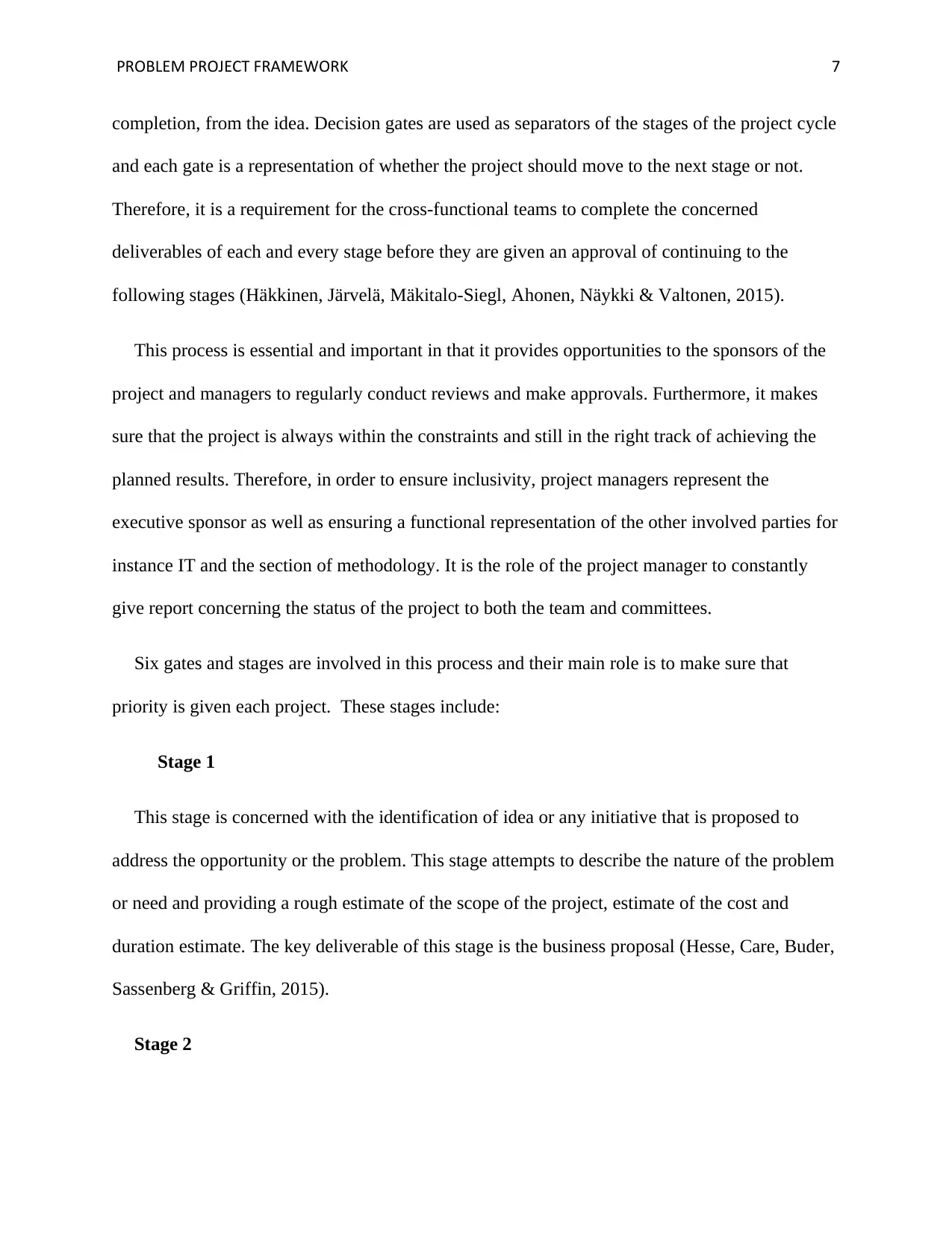
PROBLEM PROJECT FRAMEWORK 7
completion, from the idea. Decision gates are used as separators of the stages of the project cycle
and each gate is a representation of whether the project should move to the next stage or not.
Therefore, it is a requirement for the cross-functional teams to complete the concerned
deliverables of each and every stage before they are given an approval of continuing to the
following stages (Häkkinen, Järvelä, Mäkitalo-Siegl, Ahonen, Näykki & Valtonen, 2015).
This process is essential and important in that it provides opportunities to the sponsors of the
project and managers to regularly conduct reviews and make approvals. Furthermore, it makes
sure that the project is always within the constraints and still in the right track of achieving the
planned results. Therefore, in order to ensure inclusivity, project managers represent the
executive sponsor as well as ensuring a functional representation of the other involved parties for
instance IT and the section of methodology. It is the role of the project manager to constantly
give report concerning the status of the project to both the team and committees.
Six gates and stages are involved in this process and their main role is to make sure that
priority is given each project. These stages include:
Stage 1
This stage is concerned with the identification of idea or any initiative that is proposed to
address the opportunity or the problem. This stage attempts to describe the nature of the problem
or need and providing a rough estimate of the scope of the project, estimate of the cost and
duration estimate. The key deliverable of this stage is the business proposal (Hesse, Care, Buder,
Sassenberg & Griffin, 2015).
Stage 2
completion, from the idea. Decision gates are used as separators of the stages of the project cycle
and each gate is a representation of whether the project should move to the next stage or not.
Therefore, it is a requirement for the cross-functional teams to complete the concerned
deliverables of each and every stage before they are given an approval of continuing to the
following stages (Häkkinen, Järvelä, Mäkitalo-Siegl, Ahonen, Näykki & Valtonen, 2015).
This process is essential and important in that it provides opportunities to the sponsors of the
project and managers to regularly conduct reviews and make approvals. Furthermore, it makes
sure that the project is always within the constraints and still in the right track of achieving the
planned results. Therefore, in order to ensure inclusivity, project managers represent the
executive sponsor as well as ensuring a functional representation of the other involved parties for
instance IT and the section of methodology. It is the role of the project manager to constantly
give report concerning the status of the project to both the team and committees.
Six gates and stages are involved in this process and their main role is to make sure that
priority is given each project. These stages include:
Stage 1
This stage is concerned with the identification of idea or any initiative that is proposed to
address the opportunity or the problem. This stage attempts to describe the nature of the problem
or need and providing a rough estimate of the scope of the project, estimate of the cost and
duration estimate. The key deliverable of this stage is the business proposal (Hesse, Care, Buder,
Sassenberg & Griffin, 2015).
Stage 2
Paraphrase This Document
Need a fresh take? Get an instant paraphrase of this document with our AI Paraphraser
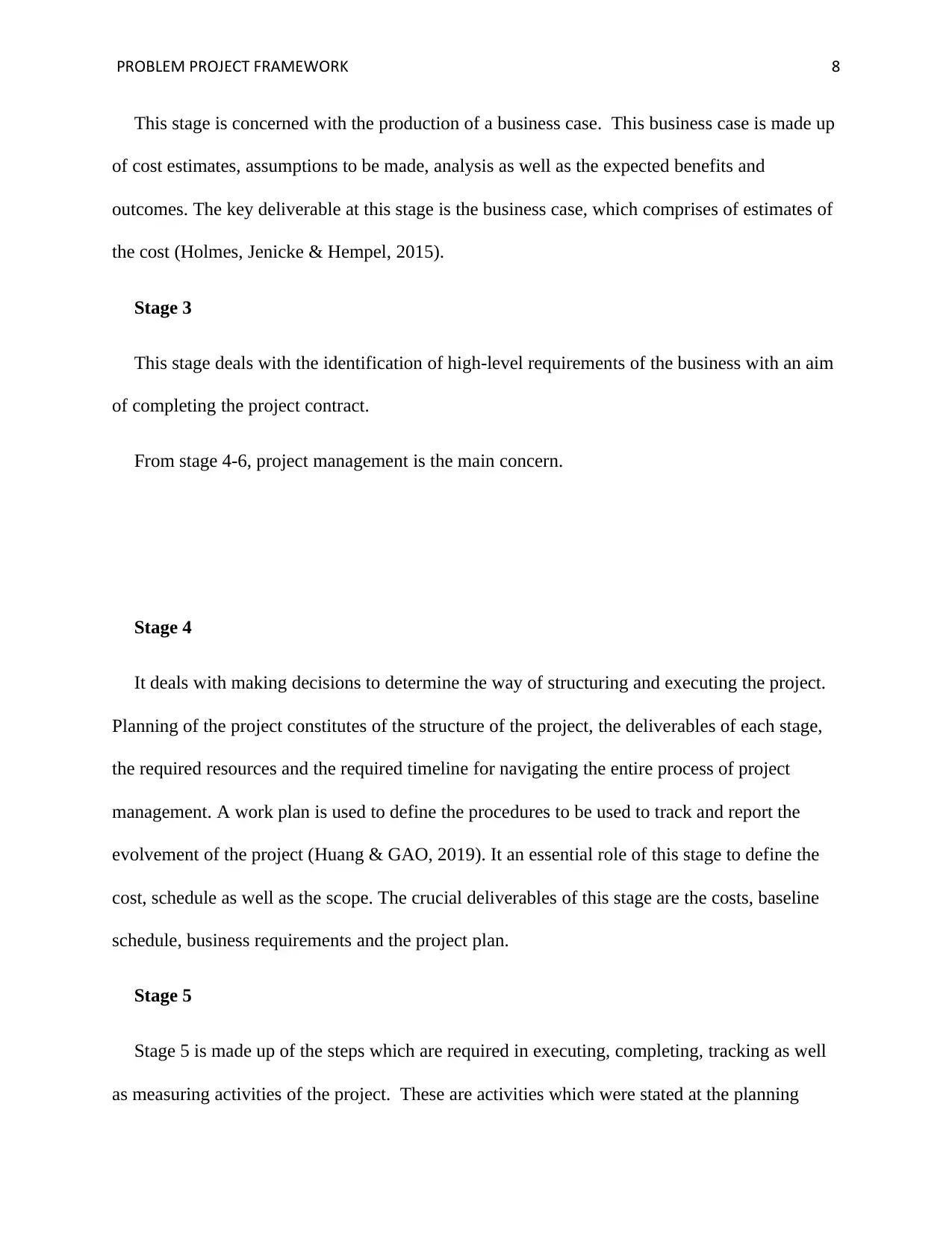
PROBLEM PROJECT FRAMEWORK 8
This stage is concerned with the production of a business case. This business case is made up
of cost estimates, assumptions to be made, analysis as well as the expected benefits and
outcomes. The key deliverable at this stage is the business case, which comprises of estimates of
the cost (Holmes, Jenicke & Hempel, 2015).
Stage 3
This stage deals with the identification of high-level requirements of the business with an aim
of completing the project contract.
From stage 4-6, project management is the main concern.
Stage 4
It deals with making decisions to determine the way of structuring and executing the project.
Planning of the project constitutes of the structure of the project, the deliverables of each stage,
the required resources and the required timeline for navigating the entire process of project
management. A work plan is used to define the procedures to be used to track and report the
evolvement of the project (Huang & GAO, 2019). It an essential role of this stage to define the
cost, schedule as well as the scope. The crucial deliverables of this stage are the costs, baseline
schedule, business requirements and the project plan.
Stage 5
Stage 5 is made up of the steps which are required in executing, completing, tracking as well
as measuring activities of the project. These are activities which were stated at the planning
This stage is concerned with the production of a business case. This business case is made up
of cost estimates, assumptions to be made, analysis as well as the expected benefits and
outcomes. The key deliverable at this stage is the business case, which comprises of estimates of
the cost (Holmes, Jenicke & Hempel, 2015).
Stage 3
This stage deals with the identification of high-level requirements of the business with an aim
of completing the project contract.
From stage 4-6, project management is the main concern.
Stage 4
It deals with making decisions to determine the way of structuring and executing the project.
Planning of the project constitutes of the structure of the project, the deliverables of each stage,
the required resources and the required timeline for navigating the entire process of project
management. A work plan is used to define the procedures to be used to track and report the
evolvement of the project (Huang & GAO, 2019). It an essential role of this stage to define the
cost, schedule as well as the scope. The crucial deliverables of this stage are the costs, baseline
schedule, business requirements and the project plan.
Stage 5
Stage 5 is made up of the steps which are required in executing, completing, tracking as well
as measuring activities of the project. These are activities which were stated at the planning
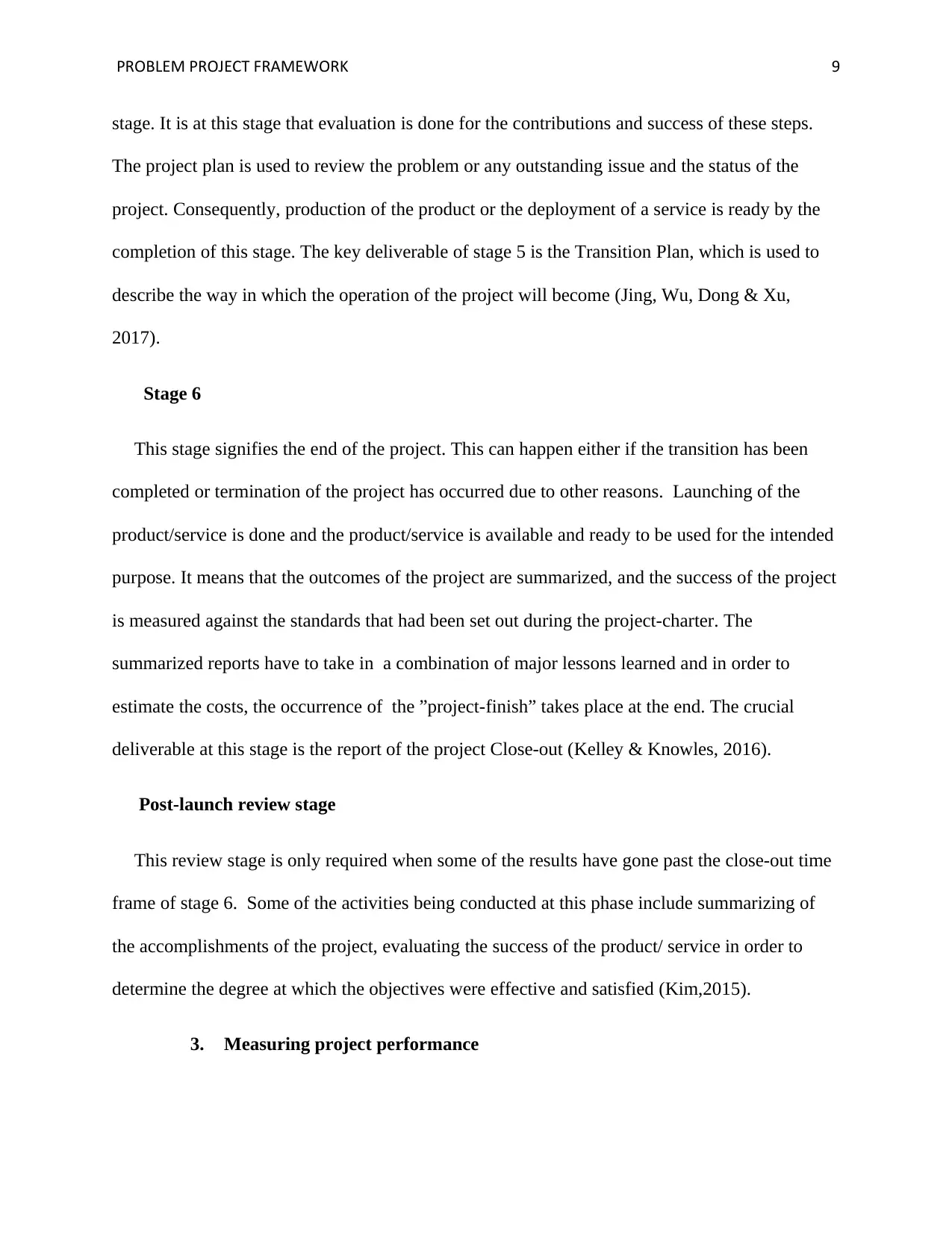
PROBLEM PROJECT FRAMEWORK 9
stage. It is at this stage that evaluation is done for the contributions and success of these steps.
The project plan is used to review the problem or any outstanding issue and the status of the
project. Consequently, production of the product or the deployment of a service is ready by the
completion of this stage. The key deliverable of stage 5 is the Transition Plan, which is used to
describe the way in which the operation of the project will become (Jing, Wu, Dong & Xu,
2017).
Stage 6
This stage signifies the end of the project. This can happen either if the transition has been
completed or termination of the project has occurred due to other reasons. Launching of the
product/service is done and the product/service is available and ready to be used for the intended
purpose. It means that the outcomes of the project are summarized, and the success of the project
is measured against the standards that had been set out during the project-charter. The
summarized reports have to take in a combination of major lessons learned and in order to
estimate the costs, the occurrence of the ”project-finish” takes place at the end. The crucial
deliverable at this stage is the report of the project Close-out (Kelley & Knowles, 2016).
Post-launch review stage
This review stage is only required when some of the results have gone past the close-out time
frame of stage 6. Some of the activities being conducted at this phase include summarizing of
the accomplishments of the project, evaluating the success of the product/ service in order to
determine the degree at which the objectives were effective and satisfied (Kim,2015).
3. Measuring project performance
stage. It is at this stage that evaluation is done for the contributions and success of these steps.
The project plan is used to review the problem or any outstanding issue and the status of the
project. Consequently, production of the product or the deployment of a service is ready by the
completion of this stage. The key deliverable of stage 5 is the Transition Plan, which is used to
describe the way in which the operation of the project will become (Jing, Wu, Dong & Xu,
2017).
Stage 6
This stage signifies the end of the project. This can happen either if the transition has been
completed or termination of the project has occurred due to other reasons. Launching of the
product/service is done and the product/service is available and ready to be used for the intended
purpose. It means that the outcomes of the project are summarized, and the success of the project
is measured against the standards that had been set out during the project-charter. The
summarized reports have to take in a combination of major lessons learned and in order to
estimate the costs, the occurrence of the ”project-finish” takes place at the end. The crucial
deliverable at this stage is the report of the project Close-out (Kelley & Knowles, 2016).
Post-launch review stage
This review stage is only required when some of the results have gone past the close-out time
frame of stage 6. Some of the activities being conducted at this phase include summarizing of
the accomplishments of the project, evaluating the success of the product/ service in order to
determine the degree at which the objectives were effective and satisfied (Kim,2015).
3. Measuring project performance
⊘ This is a preview!⊘
Do you want full access?
Subscribe today to unlock all pages.

Trusted by 1+ million students worldwide
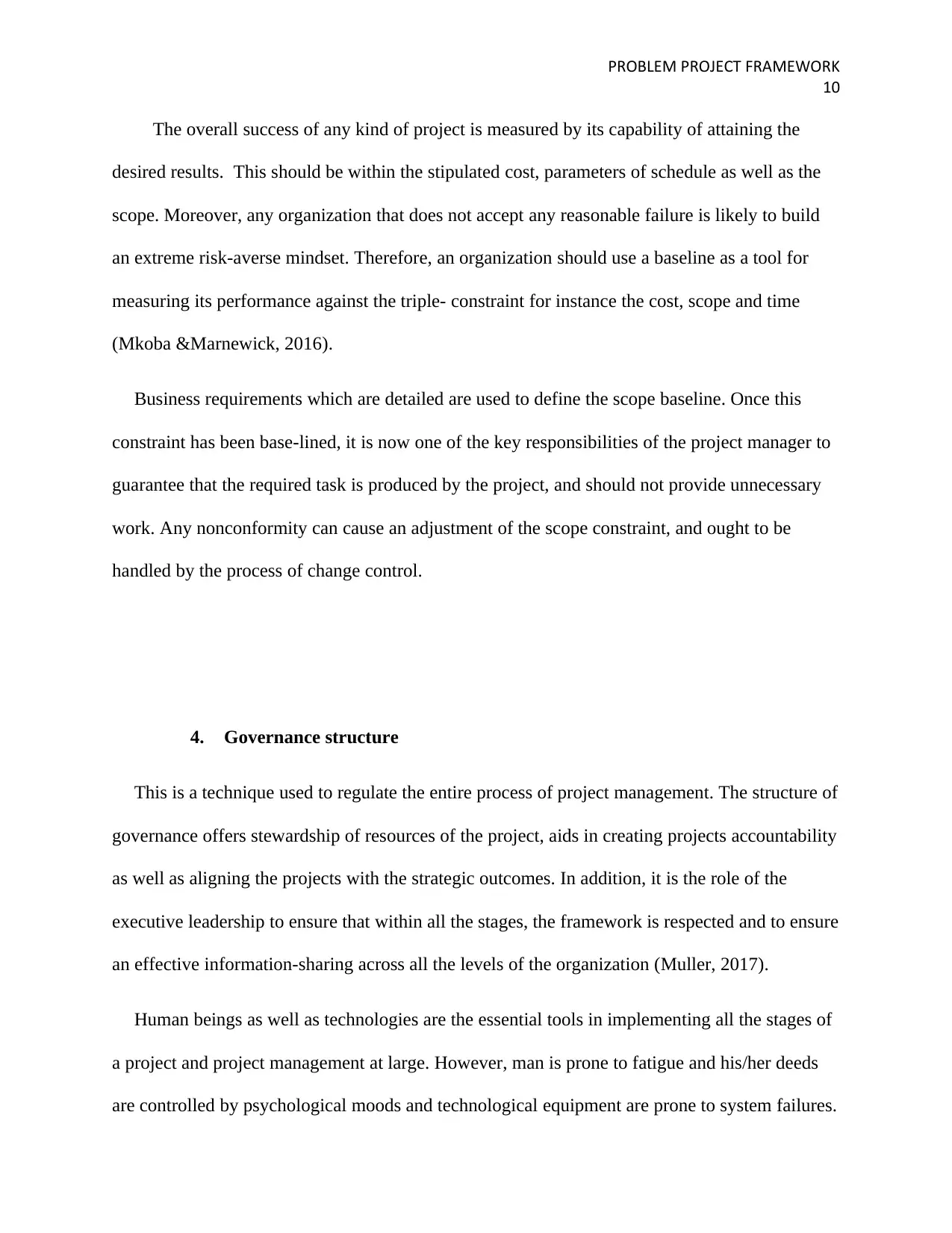
PROBLEM PROJECT FRAMEWORK
10
The overall success of any kind of project is measured by its capability of attaining the
desired results. This should be within the stipulated cost, parameters of schedule as well as the
scope. Moreover, any organization that does not accept any reasonable failure is likely to build
an extreme risk-averse mindset. Therefore, an organization should use a baseline as a tool for
measuring its performance against the triple- constraint for instance the cost, scope and time
(Mkoba &Marnewick, 2016).
Business requirements which are detailed are used to define the scope baseline. Once this
constraint has been base-lined, it is now one of the key responsibilities of the project manager to
guarantee that the required task is produced by the project, and should not provide unnecessary
work. Any nonconformity can cause an adjustment of the scope constraint, and ought to be
handled by the process of change control.
4. Governance structure
This is a technique used to regulate the entire process of project management. The structure of
governance offers stewardship of resources of the project, aids in creating projects accountability
as well as aligning the projects with the strategic outcomes. In addition, it is the role of the
executive leadership to ensure that within all the stages, the framework is respected and to ensure
an effective information-sharing across all the levels of the organization (Muller, 2017).
Human beings as well as technologies are the essential tools in implementing all the stages of
a project and project management at large. However, man is prone to fatigue and his/her deeds
are controlled by psychological moods and technological equipment are prone to system failures.
10
The overall success of any kind of project is measured by its capability of attaining the
desired results. This should be within the stipulated cost, parameters of schedule as well as the
scope. Moreover, any organization that does not accept any reasonable failure is likely to build
an extreme risk-averse mindset. Therefore, an organization should use a baseline as a tool for
measuring its performance against the triple- constraint for instance the cost, scope and time
(Mkoba &Marnewick, 2016).
Business requirements which are detailed are used to define the scope baseline. Once this
constraint has been base-lined, it is now one of the key responsibilities of the project manager to
guarantee that the required task is produced by the project, and should not provide unnecessary
work. Any nonconformity can cause an adjustment of the scope constraint, and ought to be
handled by the process of change control.
4. Governance structure
This is a technique used to regulate the entire process of project management. The structure of
governance offers stewardship of resources of the project, aids in creating projects accountability
as well as aligning the projects with the strategic outcomes. In addition, it is the role of the
executive leadership to ensure that within all the stages, the framework is respected and to ensure
an effective information-sharing across all the levels of the organization (Muller, 2017).
Human beings as well as technologies are the essential tools in implementing all the stages of
a project and project management at large. However, man is prone to fatigue and his/her deeds
are controlled by psychological moods and technological equipment are prone to system failures.
Paraphrase This Document
Need a fresh take? Get an instant paraphrase of this document with our AI Paraphraser
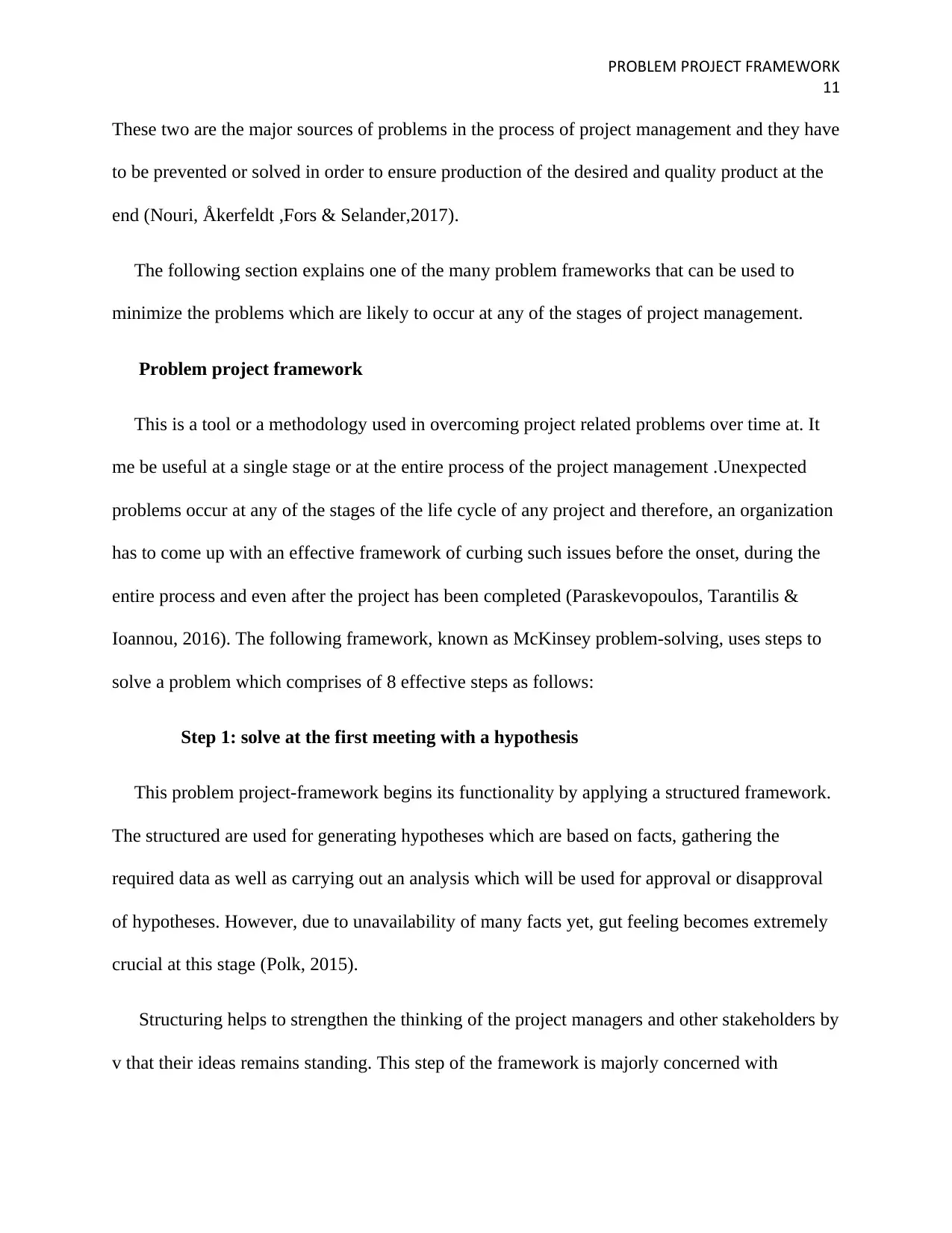
PROBLEM PROJECT FRAMEWORK
11
These two are the major sources of problems in the process of project management and they have
to be prevented or solved in order to ensure production of the desired and quality product at the
end (Nouri, Åkerfeldt ,Fors & Selander,2017).
The following section explains one of the many problem frameworks that can be used to
minimize the problems which are likely to occur at any of the stages of project management.
Problem project framework
This is a tool or a methodology used in overcoming project related problems over time at. It
me be useful at a single stage or at the entire process of the project management .Unexpected
problems occur at any of the stages of the life cycle of any project and therefore, an organization
has to come up with an effective framework of curbing such issues before the onset, during the
entire process and even after the project has been completed (Paraskevopoulos, Tarantilis &
Ioannou, 2016). The following framework, known as McKinsey problem-solving, uses steps to
solve a problem which comprises of 8 effective steps as follows:
Step 1: solve at the first meeting with a hypothesis
This problem project-framework begins its functionality by applying a structured framework.
The structured are used for generating hypotheses which are based on facts, gathering the
required data as well as carrying out an analysis which will be used for approval or disapproval
of hypotheses. However, due to unavailability of many facts yet, gut feeling becomes extremely
crucial at this stage (Polk, 2015).
Structuring helps to strengthen the thinking of the project managers and other stakeholders by
v that their ideas remains standing. This step of the framework is majorly concerned with
11
These two are the major sources of problems in the process of project management and they have
to be prevented or solved in order to ensure production of the desired and quality product at the
end (Nouri, Åkerfeldt ,Fors & Selander,2017).
The following section explains one of the many problem frameworks that can be used to
minimize the problems which are likely to occur at any of the stages of project management.
Problem project framework
This is a tool or a methodology used in overcoming project related problems over time at. It
me be useful at a single stage or at the entire process of the project management .Unexpected
problems occur at any of the stages of the life cycle of any project and therefore, an organization
has to come up with an effective framework of curbing such issues before the onset, during the
entire process and even after the project has been completed (Paraskevopoulos, Tarantilis &
Ioannou, 2016). The following framework, known as McKinsey problem-solving, uses steps to
solve a problem which comprises of 8 effective steps as follows:
Step 1: solve at the first meeting with a hypothesis
This problem project-framework begins its functionality by applying a structured framework.
The structured are used for generating hypotheses which are based on facts, gathering the
required data as well as carrying out an analysis which will be used for approval or disapproval
of hypotheses. However, due to unavailability of many facts yet, gut feeling becomes extremely
crucial at this stage (Polk, 2015).
Structuring helps to strengthen the thinking of the project managers and other stakeholders by
v that their ideas remains standing. This step of the framework is majorly concerned with
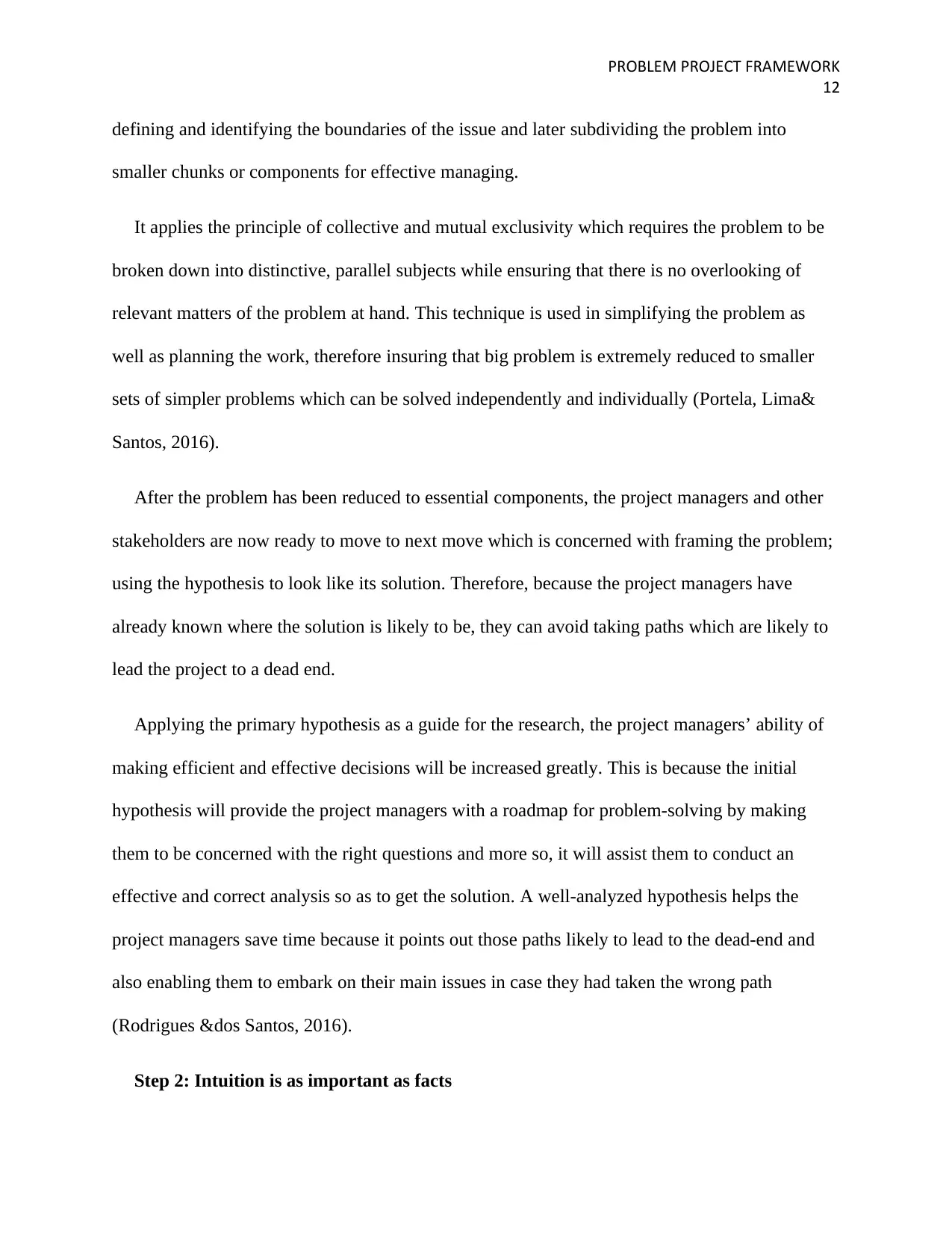
PROBLEM PROJECT FRAMEWORK
12
defining and identifying the boundaries of the issue and later subdividing the problem into
smaller chunks or components for effective managing.
It applies the principle of collective and mutual exclusivity which requires the problem to be
broken down into distinctive, parallel subjects while ensuring that there is no overlooking of
relevant matters of the problem at hand. This technique is used in simplifying the problem as
well as planning the work, therefore insuring that big problem is extremely reduced to smaller
sets of simpler problems which can be solved independently and individually (Portela, Lima&
Santos, 2016).
After the problem has been reduced to essential components, the project managers and other
stakeholders are now ready to move to next move which is concerned with framing the problem;
using the hypothesis to look like its solution. Therefore, because the project managers have
already known where the solution is likely to be, they can avoid taking paths which are likely to
lead the project to a dead end.
Applying the primary hypothesis as a guide for the research, the project managers’ ability of
making efficient and effective decisions will be increased greatly. This is because the initial
hypothesis will provide the project managers with a roadmap for problem-solving by making
them to be concerned with the right questions and more so, it will assist them to conduct an
effective and correct analysis so as to get the solution. A well-analyzed hypothesis helps the
project managers save time because it points out those paths likely to lead to the dead-end and
also enabling them to embark on their main issues in case they had taken the wrong path
(Rodrigues &dos Santos, 2016).
Step 2: Intuition is as important as facts
12
defining and identifying the boundaries of the issue and later subdividing the problem into
smaller chunks or components for effective managing.
It applies the principle of collective and mutual exclusivity which requires the problem to be
broken down into distinctive, parallel subjects while ensuring that there is no overlooking of
relevant matters of the problem at hand. This technique is used in simplifying the problem as
well as planning the work, therefore insuring that big problem is extremely reduced to smaller
sets of simpler problems which can be solved independently and individually (Portela, Lima&
Santos, 2016).
After the problem has been reduced to essential components, the project managers and other
stakeholders are now ready to move to next move which is concerned with framing the problem;
using the hypothesis to look like its solution. Therefore, because the project managers have
already known where the solution is likely to be, they can avoid taking paths which are likely to
lead the project to a dead end.
Applying the primary hypothesis as a guide for the research, the project managers’ ability of
making efficient and effective decisions will be increased greatly. This is because the initial
hypothesis will provide the project managers with a roadmap for problem-solving by making
them to be concerned with the right questions and more so, it will assist them to conduct an
effective and correct analysis so as to get the solution. A well-analyzed hypothesis helps the
project managers save time because it points out those paths likely to lead to the dead-end and
also enabling them to embark on their main issues in case they had taken the wrong path
(Rodrigues &dos Santos, 2016).
Step 2: Intuition is as important as facts
⊘ This is a preview!⊘
Do you want full access?
Subscribe today to unlock all pages.

Trusted by 1+ million students worldwide
1 out of 24
Related Documents
Your All-in-One AI-Powered Toolkit for Academic Success.
+13062052269
info@desklib.com
Available 24*7 on WhatsApp / Email
![[object Object]](/_next/static/media/star-bottom.7253800d.svg)
Unlock your academic potential
Copyright © 2020–2025 A2Z Services. All Rights Reserved. Developed and managed by ZUCOL.





